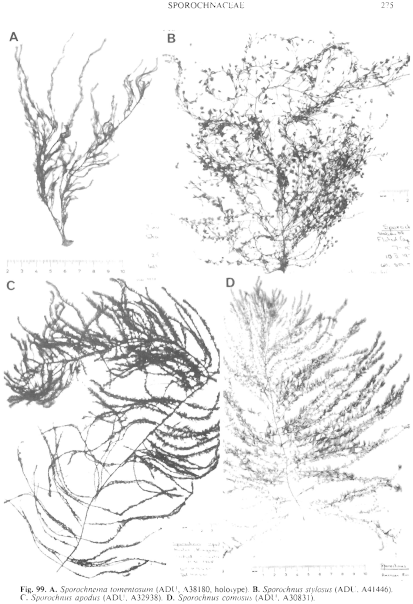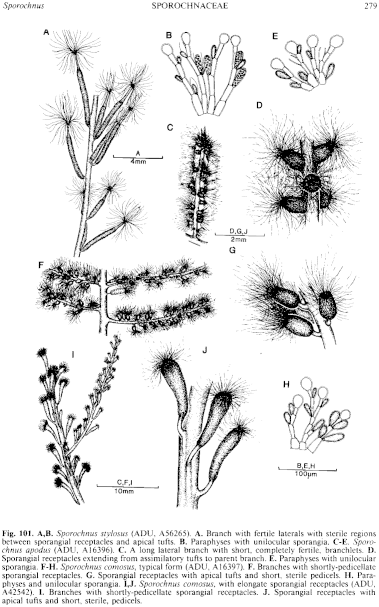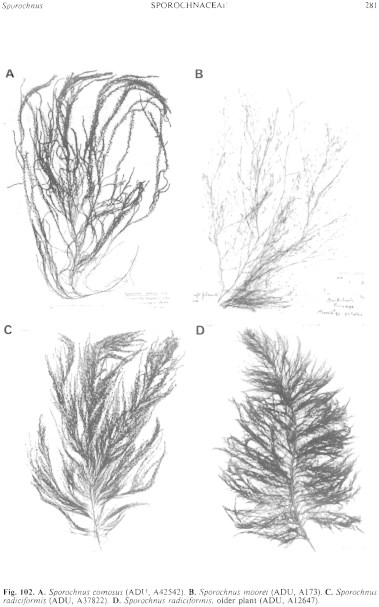|
|
|
|
|
|||||||||||
|
Electronic Flora of South Australia Species Fact Sheet
Phylum Phaeophyta – Order Sporochnales
Selected citations: Harvey 1859a: pl. 104; 1859b: 287. Womersley 1967: 240.
Synonyms
S. herculeus J. Agardh 1848: 175. Harvey 1859b: 287.
S. gracilis J. Agardh 1896: 31.
S. harveyanus J. Agardh 1896: 32.
S. decompositus J. Agardh 1896: 32.
Thallus (Figs 99D, 102A) medium to dark brown, usually 10–40 (–55) cm long, with one to a few percurrent axes bearing radially long primary laterals 2–20 mm apart, with numerous short, determinate, branchlets (Fig. 101F,I) radially arranged, each with a tuft of assimilatory filaments; attachment by a rhizoidal holdfast 1–6(44) mm across and 1–4 (–6) mm long, usually epilithic. Growth apical, with a convex branch meristem surmounted by a tuft of slender trichothallic filaments 2–4 (–9) mm long, each with a meristem (3–) 5–8 cells above their base, (14–) 18–25 mm in diameter above with cells L/B (2–) 3–7. Fronds (Fig. 101F,I) slender to moderately robust, terete, 1–2 mm in diameter in lower axes of more robust plants and 200–400 um in slender plants, decreasing to 300–400 µ in diameter near apices of robust plants and 150–200 µ in slender plants, with the short determinate branchlets 1–5(40) mm apart, 0.5–2 (–3) mm long and 70–100 µm in diameter when sterile. Structure haplostichous and pseudoparenchymatous, with a medulla of elongate cells and a single-layered, smooth-surfaced, cortex of cells 8–12 µm across and L/B 1–2 near apices, increasing to 4–6 below; older axes thickening by periclinal divisions of cortical cells.
Reproduction: Sporangial receptacles ovoid when young (Fig. 101F,G), becoming elongate-clavate and often curved (Fig. 101I,J) in older, more robust, plants, always with a sterile branch base, 0.2–2 (–6) mm long and 300–500 (–700) µm in diameter. Paraphyses (Fig. 101H) (80–) 100–160 µm and 5–6 cells long, simple or once branched, with the terminal cell larger, subspherical to pyriform, (10–) 16–22 µm in diameter, bearing lateral, clavate, unilocular sporangia 20–30 µm long and (6–) 8–10 µm in diameter.
Gametophyte unknown.
Type from "N. Holl."; in Herb. Agardh, LD, 50181.
Selected specimens: Dongara, W. Aust. (Smith, Feb. 1944; UWA). Hinders Bay, W. Aust., drift (Wollaston, 12.ii.1957; ADU, A22138). King George Sound, W. Aust., (Harvey, Alg. Aust. Exsicc. 50; ADU, A18232). Crag Point, N. Spencer Gulf, S. Aust., 12 m deep (Shepherd, 8.xi.1974; ADU, A46038, slender form). Investigator Strait, S. Aust., 41 m deep, 35°24'S, 137°07'E ( Watson, 14.i.1971; ADU, A38161). Marino, S. Aust., drift (Womersley, 22.ix.1945; ADU, A16397 and 23.i.1972; ADU, A41259-"Marine Algae of southern Australia" No. 140). Vivonne Bay, Kangaroo I., S. Aust., 0–7 m deep on jetty piles (Kraft, 15.vii.1972; ADU, A42542). American R. inlet, Kangaroo I., S. Aust., drift ( Womersley, 31.x.1966; ADU, A30831). Crawfish Rock, Westernport Bay, Vic., 5–10 m deep (Watson, 29.viii.1971; ADU, A39380). Kelso, R. Tamar, Tas. (Perrin & Lucas, March 1936; ADU, A47122 and BM—robust form). Satellite I., D'Entrecasteaux Ch., Tas., 12 m deep (Shepherd, 17.ii.1972; ADU, A41634—slender form). Urangan, Hervey Bay, Qld, drift (McKeon, 12.x.1972; ADU, A46404).
Distribution: From Dongara, W. Aust. around southern Australia and Tasmania to the Calliope River, Qld. (Saenger et al. 1979, p. 401), on rough-water coasts, to 41 m deep (robust form) or in sheltered areas 1–10 m deep.
Taxonomic notes: S. comosus is variable in robustness, with coarser forms growing in deeper water on rough-water coasts, and slender forms occurring in less deep water, often in currents, on more sheltered coasts. The length of the sporangial receptacles depends on their age as well as the ecological conditions, since they appear to increase in length as the plant ages. The above synonyms were placed under S. comosus by Womersley (1967, p. 240) and no satisfactory separation between the forms is apparent.
S. comosus is closely related to S. pedunculatus (Hudson) C. Agardh from the Northern Hemisphere (and also from New Zealand-Lindauer et al. 1961, p. 242), and detailed comparisons between these two species are needed.
References:
AGARDH, C.A. (1824). Systema Algarum. (Lund.)
AGARDH, J.G. (1848). Species, Genera et Ordines Algarum. Vol. 1. (Gleerup: Lund.)
AGARDH, J.G. (1896). Analecta Algologica. Cont. III. Ada Univ. lund. 32, 1–140, Plate 1.
HARVEY, W.H. (1859a). Phycologia Australica. Vol. 2, Plates 61–120. (Reeve: London.)
HARVEY, W.H. (1859b). Algae. In Hooker, J.D., The Botany of the Antarctic Voyage. Part III. Flora Tasmaniae. Vol. 2, pp. 282–343, Plates 185–196.
LINDAUER, V.W., CHAPMAN, V.J. & AIKEN, M. (1961). The marine algae of New Zealand. II. Phaeophyceae. Nova Hedwigia 3, 129–350, Plates 57–97.
SAENGER, P., STEPHENSON, W. & MOVERLEY, J. (1979). The subtidal fouling organisms of the Calliope River and Auckland Creek, Central Queensland. Mem. Queensl. Mus. 19, 399–412.
WOMERSLEY, H.B.S. (1967). A critical survey of the marine algae of southern Australia. II. Phaeophyta. Aust. J. Bot. 15, 189–270.
The Marine Benthic Flora of Southern Australia Part II complete list of references.
Publication:
Womersley, H.B.S. (14 December, 1987)
The Marine Benthic Flora of Southern Australia
Part II
©Board of the Botanic Gardens and State Herbarium, Government of South Australia
Illustrations in Womersley Part II, 1997: FIGS 99D, 101 F–J, 102A.

Figure 99 enlarge
Fig. 99. A. Sporochnema tomentosum (ADU, A38180, holotype). B. Sporochnus stylosus (ADU, A41446). C. Sporochnus apodus (ADU, A32938). D. Sporochnus comosus (ADU, A30831).

Figure 101 enlarge
Fig. 101. A,B. Sporochnus stylosus (ADU, A56265). A. Branch with fertile laterals with sterile regions between sporangial receptacles and apical tufts. B. Paraphyses with unilocular sporangia. C–E. Sporochnus apodus (ADU, A16396). C. A long lateral branch with short, completely fertile, branchlets. D. Sporangial receptacles extending from assimilatory tufts to parent branch. E. Paraphyses with unilocular sporangia. F–H. Sporochnus comosus, typical form (ADU, A16397). F. Branches with shortly-pedicellate sporangial receptacles. G. Sporangial receptacles with apical tufts and short, sterile pedicels. H. Paraphyses and unilocular sporangia. I,J. Sporochnus comosus, with elongate sporangial receptacles (ADU, A42542). I. Branches with shortly-pedicellate sporangial receptacles. J. Sporangial receptacles with apical tufts and short, sterile, pedicels.

Figure 102 enlarge
Fig. 102. A. Sporochnus comosus (ADU, A42542). B. Sporochnus moorei (ADU, A173). C. Sporochnus radiciformis (ADU, A37822). D. Sporochnus radiciformis, older plant (ADU, A 12647).

|
Email Contact: State Herbarium of South Australia |

|